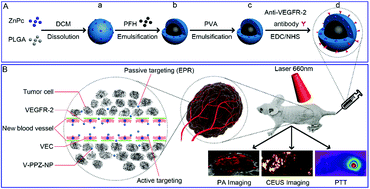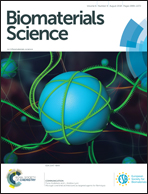PA/US dual-modality imaging to guide VEGFR-2 targeted photothermal therapy using ZnPc-/PFH-loaded polymeric nanoparticles†
Abstract
Angiogenesis is a common pathological characteristic of many solid tumors and vulnerable atherosclerotic plaques. Photothermal therapy (PTT) is a promising method to reduce neovascularization. To increase the targeting ability and efficiency of PTT, a novel polymeric nanosystem that encapsulates phthalocyanine zinc (ZnPc) and perfluorohexane (PFH) was developed to target the new blood vessels of breast tumors. After being conjugated to the anti-VEGFR-2 antibody, the polymeric nanoparticles (NPs) targeted vascular endothelial cells efficiently. The photosensitizer (PS) in the NPs could convert laser energy into heat, generating local high temperatures to kill the surrounding cells under laser irradiation. In addition, the liquid–gas phase transition of PFH was induced, and an enhanced ultrasound (US) and photoacoustic (PA) image could be obtained. US/PA imaging enables visualization of the location of NPs, and laser irradiation position can be guided to the optimal location, resulting in fewer side effects than those from traditional treatments with a high targeting ability and an efficient synergistic effect from the PTT.



 Please wait while we load your content...
Please wait while we load your content...